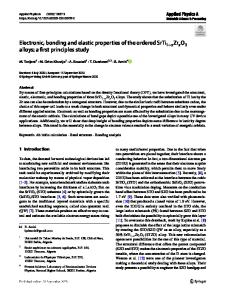Electronic properties of type-II $$\hbox {GaAs}_{1-x} \hbox {Sb}_{x}$$ GaAs 1 - x Sb x /GaAs quantum rings for ap
- PDF / 1,656,048 Bytes
- 15 Pages / 439.37 x 666.142 pts Page_size
- 7 Downloads / 283 Views
Electronic properties of type‑II GaAs1−x Sbx/GaAs quantum rings for applications in intermediate band solar cells Reza Arkani1,2 · Christopher A. Broderick1,2 · Eoin P. O’Reilly1,2 Received: 16 September 2019 / Accepted: 21 September 2020 © Springer Science+Business Media, LLC, part of Springer Nature 2020
Abstract We present a theoretical analysis of the electronic properties of type-II GaAs1−x Sbx/GaAs quantum rings (QRs), from the perspective of applications in intermediate band solar cells (IBSCs). We outline the analytical solution of Schrödinger’s equation for a cylindrical QR of infinite potential depth, and describe the evolution of the QR ground state with QR morphology. Having used this analytical model to elucidate general aspects of the electronic properties of QRs, we undertake multi-band k·p calculations—including strain and piezoelectric effects—for realistic GaAs1−x Sbx/GaAs QRs. Our k·p calculations confirm that the large type-II band offsets in GaAs1−x Sbx/GaAs QRs provide strong confinement of holes, and further indicate the presence of resonant (quasi-bound) electron states which localise in the centre of the QR. From the perspective of IBSC design the calculated electronic properties demonstrate several benefits, including (i) large hole ionisation energies, mitigating thermionic emission from the intermediate band, and (ii) electron-hole spatial overlaps exceeding those in conventional GaAs1−x Sbx/GaAs QDs, with the potential to engineer these overlaps via the QR morphology so as to manage the trade-off between optical absorption and radiative recombination. Overall, our analysis highlights the flexibility offered by the QR geometry from the perspective of band structure engineering, and identifies specific combinations of QR alloy composition and morphology which offer optimised sub-band gap energies for QR-based IBSCs. Keywords Solar cell · Quantum ring · Intermediate band · Band structure engineering · k.p method
This article is part of the Topical Collection on Numerical Simulation of Optoelectronic Devices. Guest edited by Angela Thränhardt, Karin Hinzer, Weida Hu, Stefan Schulz, Slawomir Sujecki and Yuhrenn Wu. * Christopher A. Broderick [email protected] 1
Tyndall National Institute, University College Cork, Lee Maltings, Dyke Parade, Cork T12 R5CP, Ireland
2
Department of Physics, University College Cork, Cork T12 YN60, Ireland
13
Vol.:(0123456789)
470
Page 2 of 15
R. Arkani et al.
1 Introduction Intermediate band solar cells (IBSCs) (Luque and Martí 1997; Okada et al. 2015) constitute an attractive approach to develop next-generation solar cells, since they offer the potential to significantly exceed the single-junction Shockley–Queisser (detailed balance) photovoltaic efficiency limit (Shockley and Queisser 1961). This is achieved via introduction of an intermediate band (IB) lying energetically within the band gap of a host matrix semiconductor. In the case that the IB is electrically isolated from both the valence band (VB) and conduction band (CB) of th
Data Loading...











